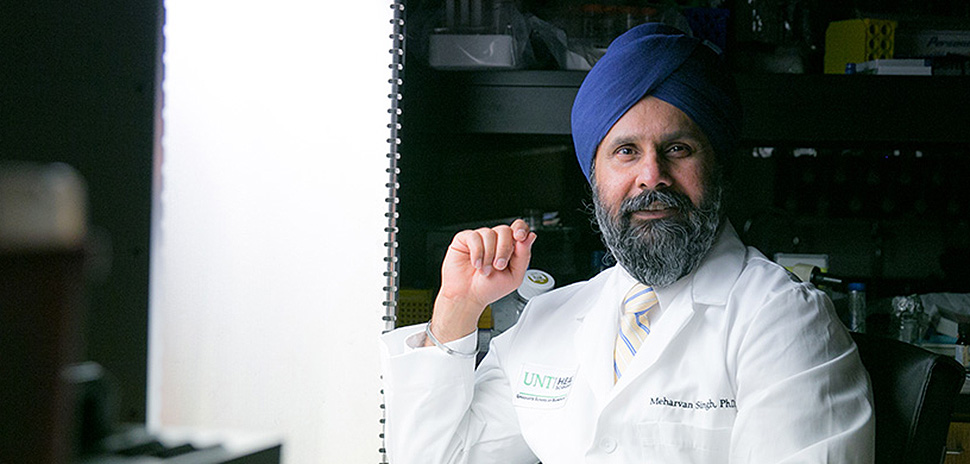![]() Every week, we do a little research of our own. We’re looking for scientists, professors, engineers, entrepreneurs—anybody, really—engaging in research and development across North Texas.
Every week, we do a little research of our own. We’re looking for scientists, professors, engineers, entrepreneurs—anybody, really—engaging in research and development across North Texas.
There’s plenty of good work being done. If you want to put R&D under your microscope, sign up for our e-newsletter.

Meharvan Singh, professor of pharmacology and neuroscience at the University of North Texas Health Science Center in Fort Worth [Photo Courtesy UNT Health Science Center]
UNTHSC team hopes to stretch the timeframe for stroke treatment
When the clock starts ticking after you have a stroke, speed is of the essence—you only have three to four hours to get to a hospital and receive what could be a lifesaving, disability-reducing medication.
“What happens is people feel like they have the worst headache of their life, so they might go to bed and try to sleep it off.”
Meharvan Singh
Many times, people don’t make it, and that timeframe is something that Meharvan Singh, professor of pharmacology and neuroscience at the University of North Texas Health Science Center in Fort Worth, is working to lengthen.
Singh and a team of researchers have developed a novel therapeutic strategy to help the brain heal and to improve recovery chances. After all, you might be one of the roughly 800,000 people who have a stroke each year.“What happens is people feel like they have the worst headache of their life, so they might go to bed and try to sleep it off,” he said. “Even if they do recognize their symptoms as that of a stroke, by the time they get to the hospital they will have likely missed that window for treatment.”
Singh and his colleagues, Dr. Trinh Nguyen and Chang Su recently published a study on the role of miRNA let-7i in regulating the protective function of the female hormone progesterone in a stroke. UNTHSC said in a release that microRNAs are small RNA molecules that play an important role in regulating gene expression. You can find out more about the research here.

A 3D image of a heart. [Photo Courtesy Children’s Health]
UT Southwestern studies heart failure in African-Americans
Researchers at UT Southwestern Medical wanted to know why African-Americans experience certain cardiac conditions, at a younger age than Caucasians, that are linked to a greater occurrence of heart failure. And, they have answers, UTSW said in a release.
The researchers analyzed data from the Dallas Heart Study in their quest for answers and published their findings in JAMA Cardiology. They analyzed data from 1,251 African-Americans and 826 caucasians enrolled in the study.
“The basis of these differences remains uncertain. For example, it is not known to what extent genetic and/or environmental risk factors account for these differences.”
Dr. Mark Drazner
“In our study, genetically determined African ancestry was associated with two factors that are connected with an increased risk of heart failure—higher voltage on an electrocardiogram and thickening of the left ventricle,” senior author Dr. Mark Drazner, professor of internal medicine and clinical chief of cardiology, said in a release.
UT Southwestern said that its genetics experts examined more than 25,000 DNA variations across the genome to estimate the amount of African ancestry for each participant. It said that self-identified black participants of the Dallas Heart Study were estimated to have an average of 86 percent African ancestry. And, they found that genetically inferred African ancestry was more closely correlated with ECG voltage and thickening of the left ventricle than self-reported ethnic identity, according to the release.
“On average, blacks have hearts that are thicker and heavier than whites,” said Drazner, the James M. Wooten Chair in Cardiology. “Also, they have higher electrocardiographic voltages. The basis of these differences remains uncertain. For example, it is not known to what extent genetic and/or environmental risk factors account for these differences.”
The American Heart Association reports that hypertension is very prevalent among African-Americans and contributes directly to the higher occurrences of strokes, heart failure, and peripheral artery disease among people in that group.
READ NEXT
R&D: UTA Scientist Examines Why We Exist; UNTHSC Institute Aims to Speed Memory Loss Care
![]()
































